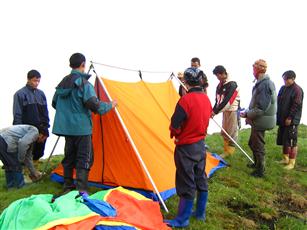Ecotourism Component

The ecotourism component is designed to develop and improve the sector for the benefit of local forest fringe communities while ensuring environmental conservation. It focuses on
-
policy, strategy, regulation, and resolving bottlenecks impeding the development of the sector;
-
marketing Sikkim?s ecotourism opportunities and creating linkages between suppliers;
-
developing areas for specific forms of tourism;
-
developing ecotourism facilities;
-
improving the design, production, and sales of handicrafts;
-
devising a waste management collection and disposal system at selected tourist areas;
-
capacity development.
The ecotourism component of the project has two principal objectives:
1) providing income generation opportunities to local communities living in the forest fringe, and
2) ensuring that the impacts of developing ecotourism do not damage the environment.
The impacts of this component are three-fold:
Ecotourism is developed in every district of Sikkim following sound environmental and business principles, restrictions impeding the operation of ecotourism are eased, and the sector is well understood by all stakeholders. Ecotourism in Sikkim is strongly marketed in India and abroad, and awareness of the ecotourism opportunities available to enjoy is raised in the appropriate marketplaces. Many jobs are created for the local communities, and income generation opportunities are improved and multiplied. The main public sector implementation organizations and partners are the Forestry Department, executing the project through the JFMC, EDC, and PSS schemes, and the Tourism Department. Other state government departments will be brought in for implementation of certain project components. The main partners in the private sector include the Travel Agent Association of Sikkim (TAAS), the Sikkim Association of Adventure Tour Operators (SAATO), and the Sikkim Hotel and Restaurant Association (SHRA) as well as the local communities that are or will become tourism service providers. NGOs will also be involved in certain activities. This component links with several other components in the project such as the development of national parks in Sikkim; biodiversity and environmental conservation; income generation; microfinance; and capacity building of government officers, JFMCs, EDCs, and PSS?s as well as local communities.
In principle, activities such as the establishment of JFMCs, EDCs, PSS?s, and SHGs and the provision of training to their members will be implemented through the joint forest management component. Ecotourism activities of local communities will be treated as income generation activities (IGAs) of SHGs and will be eligible for receiving project support through, for example, the microfinance to be provided through the JFMCs, EDCs, and PSS?s.